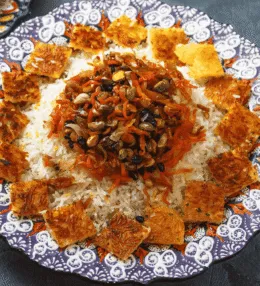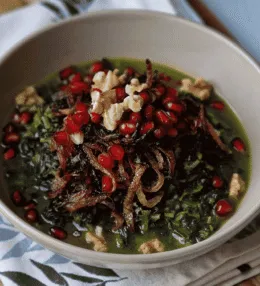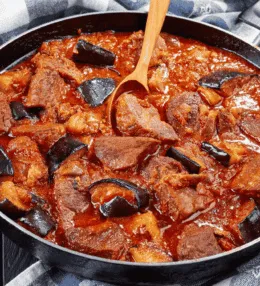
- View
Table of Contents
ToggleGaeng Keow Wan, or Thai Green Curry, is a dish that perfectly captures the balance and complexity that makes Thai cuisine so beloved around the world.
With its creamy coconut milk base and fragrant green curry paste, this dish brings together layers of spice, sweetness, and a gentle heat that excites the palate.
Whether enjoyed with tender chicken, tofu, or a medley of vegetables, Gaeng Keow Wan is a delicious expression of Thailand‘s culinary traditions, offering both depth and freshness in every bite.
Want to dive deeper into Thai Cuisine? Don’t miss our post on 36 Traditional Thai Foods To Try
What Is Gaeng Keow Wan?
Gaeng Keow Wan, often referred to as Thai Green Curry, is one of Thailand’s most iconic dishes. The name “Keow Wan” translates to “sweet green,” a nod to the curry’s vibrant colour and the slightly sweet undertones that balance its heat.
The dish is built around a green curry paste, made from a combination of fresh green chilies, garlic, lemongrass, kaffir lime leaves, and other herbs and spices. This paste is then simmered in rich coconut milk, creating a sauce that is both creamy and aromatic.
The curry is typically cooked with a protein such as chicken, shrimp, or tofu, along with vegetables like eggplant, bamboo shoots, or bell peppers.
Fresh Thai basil and a splash of fish sauce bring the flavours to life, while the addition of palm sugar adds a subtle sweetness that complements the heat from the chilies. Served with jasmine rice, Gaeng Keow Wan is a meal that is at once comforting and vibrant, rich in flavour and texture.
Ingredients and Taste
The heart of Gaeng Keow Wan lies in its green curry paste, which is made by pounding together fresh green chilies, garlic, shallots, lemongrass, and galangal.
These ingredients form the base of the dish, giving it a punch of heat and fragrance. Kaffir lime leaves add a citrusy brightness, while shrimp paste and fish sauce introduce a layer of savoury umami.
Coconut milk is then added, mellowing out the sharpness of the spices and creating a smooth, luxurious texture. The balance of flavours in Gaeng Keow Wan is what makes it truly special. The coconut milk lends a creamy richness, while the green curry paste provides heat and freshness.
The sweetness from the palm sugar tempers the spiciness, creating a curry that is warm but not overwhelming. Thai basil, with its slightly peppery note, adds a final touch of brightness that ties the dish together. Each spoonful is a complex blend of creamy, spicy, sweet, and fragrant, an experience that leaves a lasting impression.
A Taste of History
Gaeng Keow Wan is a relatively modern addition to Thai cuisine, thought to have been developed in the early 20th century. Its origins reflect the diversity of Thai culinary influences, combining local ingredients like fresh herbs and chilies with cooking techniques introduced from neighbouring countries.
The use of coconut milk, for instance, highlights the influence of Indian curries, while the fresh green chilies and kaffir lime speak to the distinctly Thai approach to balancing flavours. Over time, Gaeng Keow Wan has become a staple in Thai households and restaurants, celebrated for its unique flavour profile that balances sweetness, spice, and creaminess.
It’s often served during special occasions and family gatherings, where its bold flavours and rich sauce are a crowd pleaser. The dish’s popularity has since spread internationally, with variations appearing in Thai restaurants worldwide, though the essence of its preparation remains tied to its Thai roots.

Gaeng Keow Wan (Thai Green Curry)
Ingredients
- 500 g chicken thighs or breasts thinly sliced
- 2 tbsp green curry paste store-bought or homemade
- 400 ml coconut milk
- 1 cup water or chicken broth
- 2 tbsp fish sauce
- 1 tbsp palm sugar or brown sugar
- 4 kaffir lime leaves torn
- 1 small eggplant diced
- 100 g bamboo shoots optional
- 1 red chili sliced (for garnish)
- 1 handful Thai basil leaves
- 1 cup baby corn or snap peas
- 1 tbsp vegetable oil
- Cooked jasmine rice for serving
Instructions
- To begin, place a medium-sized pot or wok over medium heat. Add 1 tablespoon of vegetable oil and let it warm for about a minute. Once heated, add 2 tablespoons of green curry paste and stir constantly for 1-2 minutes to release the aromatic oils from the curry paste. This step ensures a deep, flavourful base for your curry.
- Slowly pour in half of the coconut milk (200ml) while stirring. Let the mixture simmer for 3-4 minutes, allowing the coconut milk to separate slightly and enhance the richness of the curry. Stir until you see an oily sheen on the surface, indicating the paste and milk have blended well.
- Add the sliced chicken pieces into the pot. Stir and coat the chicken in the fragrant curry paste and coconut milk mixture. Cook for 5-7 minutes, or until the chicken begins to turn white on the outside but is not fully cooked through.
- Pour in the remaining 200ml of coconut milk along with 1 cup of water or chicken broth. Stir to combine, ensuring the chicken is fully submerged in the liquid. Let the curry come to a gentle simmer over medium heat.
- Add the diced eggplant, bamboo shoots (if using), and baby corn or snap peas. Stir well to distribute the vegetables evenly in the curry. Cook for 10-12 minutes, until the vegetables are tender but still have a slight bite.
- Season the curry by adding 2 tablespoons of fish sauce and 1 tablespoon of palm sugar. Tear the kaffir lime leaves and add them to the pot. Stir the mixture, allowing the sweet, salty, and citrusy flavors to meld together. Taste and adjust seasoning if necessary, add more fish sauce for saltiness or palm sugar for sweetness.
- Once the chicken is fully cooked and the vegetables are tender, turn off the heat. Stir in a handful of Thai basil leaves, allowing them to wilt gently in the residual heat. The basil adds a fragrant, slightly peppery finish to the curry.
- To serve, ladle the green curry into bowls, ensuring a generous portion of chicken and vegetables in each. Garnish with sliced red chili for a pop of colour and extra heat, if desired. Serve alongside steamed jasmine rice to soak up the rich, flavourful sauce.
Nutrition
You May Also Like






